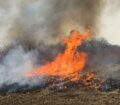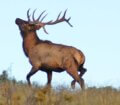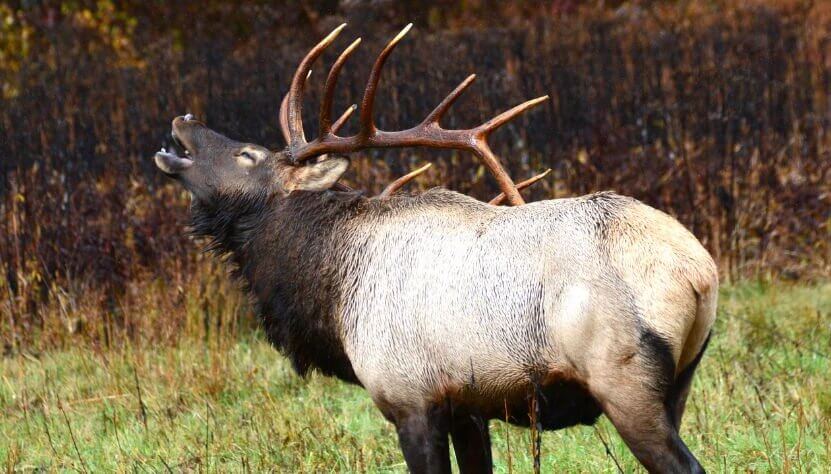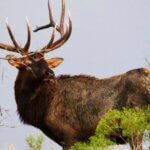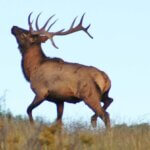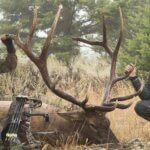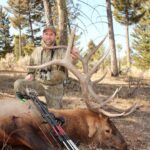Editor’s Note: Will Primos of Flora, Mississippi, has been hunting elk every year since 1988. “I’ve had some fantastic opportunities in my lifetime to call in hundreds of bull elk,” he explains. Primos, the creator of Primos Hunting (https://www.primos.com/) and generally hunts for elk in three states annually. He’s been producing videos and products for the elk-hunting industry for many years. “We wanted to get the public excited about not just elk but hunting and protecting them as well,” Primos says. “We’re strong supporters of the Rocky Mountain Elk Foundation and its mission.” Primos doesn’t just call and take elk himself, he also guides and calls for other people. Primos has taken or called more than 200+ elk for others for his videos.
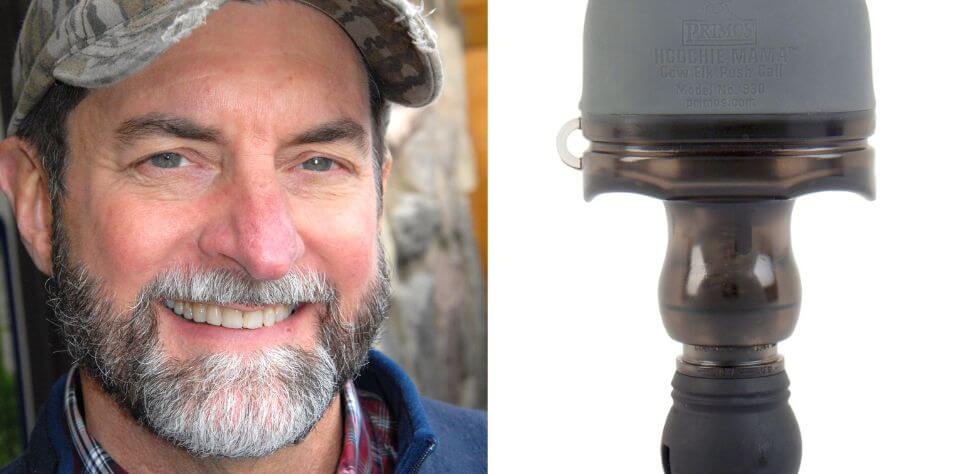
For 35 years, I’ve been hunting and calling elk. I’ve probably called in 300-bull elk throughout my entire career, but I haven’t killed nearly as many (I can only take one bull in each state). However, I may hunt with 10 or 12 other people during the season. When I call in bulls for them, I may call in as many as 10-20 elk before the hunter takes the shot. I don’t say this to brag, but it explains how I’ve gotten my education on hunting and calling elk. Over time, I’ve been able to learn what does and doesn’t work to get a bull elk within range for a bowhunter or gun hunter.
When I do seminars, one of the first questions I’m asked is, “What elk call do you recommend for a beginning elk hunter?” Regardless of whether you live out West, or if you’re an eastern hunter going hunting in the West, most elk hunters don’t live in a place where they can hear elk every day, which makes learning the language of an elk more difficult. The primary language an elk hunter needs to learn to be successful is the language of the cow elk, since the bull elk is searching for a cow. Therefore, if you learn that language as well as what to say and when to say it, you’re much more likely to get a bull within range as opposed to using the vocalizations of a bull.
Now having said that, there are some great advantages of learning the bull’s language also. The call that I recommend for most beginning elk hunters is the Primos Hoochie Mama, a mechanical elk call that allows you to push the call with your finger to create the high to low sound of a cow elk. The cow call is what I term as a sliding note as opposed to a breaking-type note like a turkey call. It’s much easier to use and learn the sound of a cow elk as opposed to a mouth call or an open-reed call. A mouth call like the Hyper Lip or the Mewie Grande are great calls, but the Hoochie Mama, I believe, is the best call for the beginner elk hunter to use. It’s easy and effective.
The first thing that an elk hunter must do when he hears an elk bugle, growl or make any other sounds is to check the wind. You’ve got to know which way the wind is blowing, so the elk won’t smell you. To be a successful elk hunter, the wind has to be in your face to keep your scent from traveling in the elk’s direction. One of the reasons my friends and I have been so successful with taking elk is that we always have three or four people on the hunt with us – including the shooter, the caller, the videographer and sometimes, a guide. When we hear an elk or reach the place where we want to be before we call the elk, we make sure that we’re not in a really-open area. We want the elk to come looking for us. This means that we rarely, if ever, get behind any type of cover.

The shooter will stand in front of, behind or beside a big tree. Next the shooter will start ranging different landmarks with his range finder. Then, when a bull walks past one of those landmarks, he knows the distance he is from the elk and can adjust his sights for that range (if bowhunting). You don’t have to worry about a cameraman getting behind the shooter, if you’re not filming. However, once the shooter is in position, the caller starts backing away from the shooter, keeping the wind in his favor and staying about 75-150 yards away behind the shooter. He also needs to be slightly to one side of the shooter, so the elk will come into the shooter broadside.
By setting-up this way, when the bull elk comes in, he’ll stop at least 75-yards away from where he hears the call coming. A bull is tall and can see a long way. He wants to see the cow, if possible, before he goes to her. When he gets to that 75 yards, he’ll stand there and bugle to the cow he hears calling because he doesn’t want to go to that cow, knowing that every predator in the woods can hear the same thing. He’s cautious because he easily can get a horn put in his side by another bull or be attacked by a mountain lion or a bear.
Once the bull finally walks in, he’ll come in broadside and stop right in front of the shooter. Many seasoned elk hunters know this tactic, but many elk hunters don’t. Some people don’t like to take a caller with them but prefer to be both the shooter and the caller. However, after years of hunting and filming elk at Primos, we’ve found this system pays off in big bulls more consistently than having the same person shoot and call, especially when bowhunting.
When Ronnie “Cuz” Strickland of Mossy Oak and I first started hunting together, one of us would run the camera and do the calling, while the other was the shooter. We soon learned that when the videographer or the hunter did the calling, and we happened to find a stupid bull that would come straight in, that bull often would stop at 20 yards and look straight at us. Then the only shot that a shooter might have would be at that bull’s throat, which was only about the size of a softball or a grapefruit. If the elk moved at the sound of the bow when you shot, you’d usually make a bad shot and probably only wound the bull. That’s why the broadside shot is worth the work.
Tomorrow: Learning about and Enjoying Elk
Looking for more content? Check out our YouTube channel and watch History of the Oggun Tractor by John E. Phillips.
Expert Guidebooks on Elk Hunting: Best Sellers

Secrets for Hunting Elk
The quickest, easiest (if there is an easy way), and safest way to find and take that bull elk of a lifetime will be to hunt with a guide.
Chad Schearer, a longtime Montana guide and TV personality, told me, “My hunter is my gun. If I get to the elk, and my hunter isn’t with me, then we don’t take the elk. My job is not only to find the elk but also to help the hunter get to the elk and make the experience as enjoyable as I can for him.” That’s the kind of fella with whom I want to go elk hunting.
An elk hunt can be tough, but it doesn’t have to be so tough that you don’t enjoy it. That’s why this elk hunting book starts with the confessions of an elk guide and with Chad Schearer’s philosophy of what the guide and the hunter’s relationship should be.
A good portion of your success will depend on your physical condition, and Matt Morrett of Harrisburg, Pennsylvania explains how an eastern hunter can get ready physically during June and July to hunt western elk, the animals he describes as, “Like deer or turkeys on steroids.”
Wayne Carlton, well-known elk hunter and TV and video personality from Montrose, Colorado, tells us what types of elk calls to use and what to say to the elk. Mike Miller of Colorado, another elk guide and Mossy Oak video personality, has tactics for the best equipment for bowhunting and gun hunting elk.
You’ll learn helpful strategies and hunting tips in this book, as well as some straightforward hunting methods that will help to make your elk hunt more successful.
“Thanks to the advice in your elk hunting books, I was able to call up a nice 6-point (6X6) bull elk! He was bugling like crazy. I called him in from about a ¼ mile away. Called him into bow range (about 40 yards away). It was a thrill!” ~Rob Brannon
VERSIONS: AUDIBLE & KINDLE

Elk: Keys to 25 Hunters’ Success
Often just one tip or tactic makes the difference in whether you take an elk home to dinner or have to hike back to the truck by yourself. In John E. Phillips’ latest elk book, Elk: Keys to 25 Hunters’ Success, you’ll learn from successful elk hunters the strategies they use to find and take elk.
Many know that the technique that seems to work most often is to hunt where other elk hunters don’t and understand where the elk are before you go on a hunt by studying data from each state, visiting HuntData (see chapter 1), examining maps, and reading postings on elk forums.
This book also tells you how to get ready physically for an elk hunt, including participating in Train to Hunt Competitions, what gear you need to take, how to enjoy a successful do-it-yourself elk hunt, or how to pick the best elk guide for you. You’ll also hear about the X System and the Broken Y System of hunting elk.
Although no one person has all the answers on how to help you find and take your elk, I’m convinced that this book’s outdoors men and women will teach you how to have satisfying elk hunts.
As my friend Karl Badger once told me, “Elk hunting doesn’t get any better than when I ride horses into the high backcountry, see two grizzly bears, hear a pack of wolves howl close to camp all night long, eat plenty of delicious food prepared on a fire and enjoy the company of good friends.”
VERSIONS: AUDIBLE, KINDLE & PRINT

How to Find Your Elk and Get Him in Close will teach you the tactics of 10 nationally known elk hunters, to help put that giant bull that’s been screaming at you from afar, in your lap. You’ll learn what some of the best guides, outfitters, and successful elk hunters do to find elk and get them in really close.
Also in this audiobook, you’ll notice that the majority of the experts call elk to within bow range. We selected numerous bowhunters and bowhunting guides, since the bowhunter has to get much closer to a bull than the gun hunter does – often less than 20 or 30 yards – practically in your lap.
On one elk hunt, I’d heard this bull bugle all morning. My guide had called him within 30 yards, and he was standing just inside black timber. I saw the smoke from his nose wafting out into the icy air less than 30-yards away. All the bull had to do was step out, and I could take the shot with my bow. But then, through no fault of my guide or me, the bull vanished.
The only conclusion I could come up with to understand why the bull I wanted to take with my bow hadn’t stepped out and given me a shot, was because he got raptured. He evidently had left the earth with no trace of himself.
This hunt was when I started wanting to learn more about hunting elk up close. In this book, I’ve tried to find some of the most knowledgeable, experienced, and practical elk hunters. I’ve always found that the best way to learn any outdoor skill, is to either hunt or fish with the best sportsmen in that field.
Often, in elk hunting, that means elk guides, who generally hunt every day of the season and receive a salary for every hunter they guide. So, I’ve put together a group of some of the best elk hunters I know to help us all learn how to find bull elk and get them in close.
VERSIONS: AUDIBLE, KINDLE & PRINT

